The North Slope
Travel to the polar regions takes time and preparation. Before leaving to visit George Divoky on Cooper Island for my Witnessing Climate Change expedition, I prepared a set of Pocket Palettes with my favorite colors.
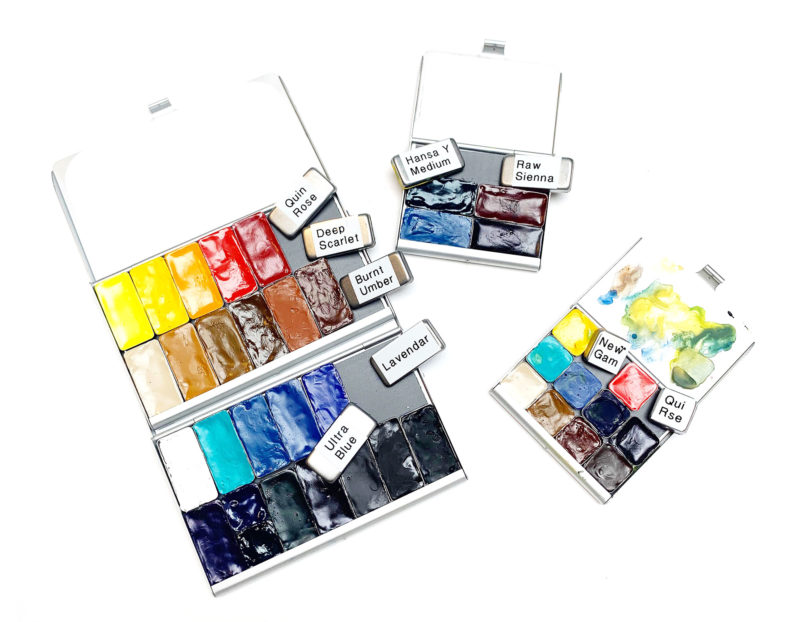
I carried a warm palette of 14 colors, a cool palette of 14 colors:
- Warm Top Row: Hansa Yellow Light, Hansa Yellow Medium, Yellow Ochre, Cadmium Red Medium Hue, Quinacridone Coral, Quinacridone Rose, Deep Scarlet
- Warm Bottom Row: Buff Titanium, Raw Sienna, Monte Amiata Natural Sienna, Quinacridone Gold, Lunar Earth, Transparent Red Oxide, Burnt Umber
- Cool Top: White Gouache, Cobalt Teal Blue, Manganese Blue, Cerulean Blue, Cobalt Blue, Ultramarine Blue, Lavender
- Cool Bottom: Phthalo Blue (RS), Phthalo Blue (GS) & Phthalo Blue Green (BS) in mini pans, Undersea Green, Indanthrone Blue, Jane’s Grey, Lunar Black, Hematite.
I also prepared a small Demi palette filled with a set of limited colors based on what I’ve previously used in polar regions and related studio work: Hansa Yellow Medium, Raw Sienna, Quinacridone Rose, Deep Scarlet, Cerulean Blue Chromium, and Indanthrone Blue (all Daniel Smith). Finally, I made an extra with bright colors just for fun which, (forehead smack!), I accidentally left at home!
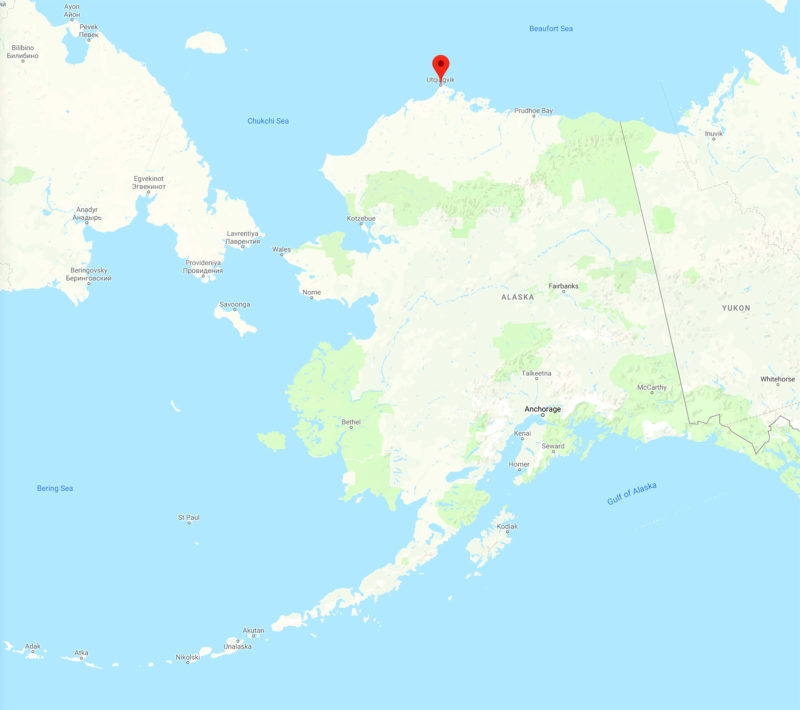
To reach Cooper Island, we first had to travel to Utqiagvik (formally Barrow), located on the North Slope of Alaska, at about 71° north. My travel companion, science educator Katie Morrison, and I headed to the airport bright and early and I was grateful for her good company. We were laden with our gear as well as additional supplies for camp at Cooper Island.
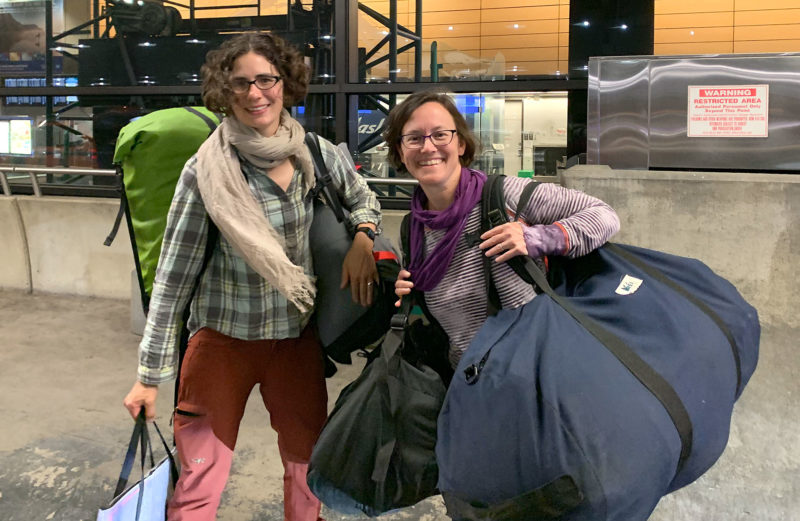
I enjoy sketching in airports and on planes. I worked quickly, creating small thumbnail sketches of the view out the window.

I explored the range of colors I could mix using my limited Demi Palette.
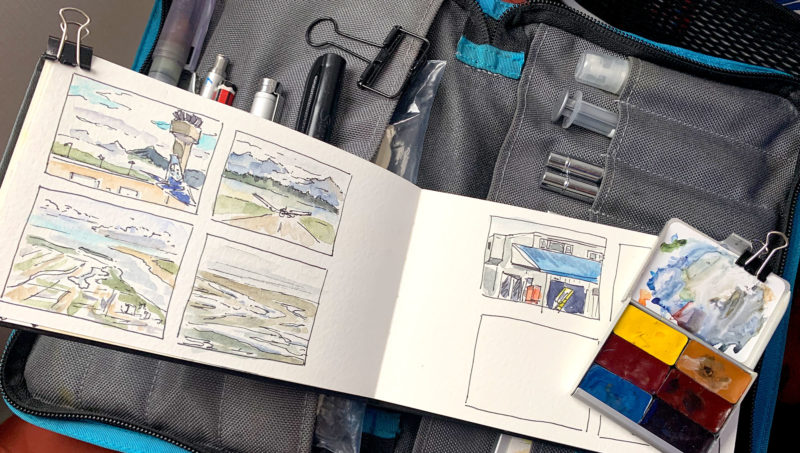
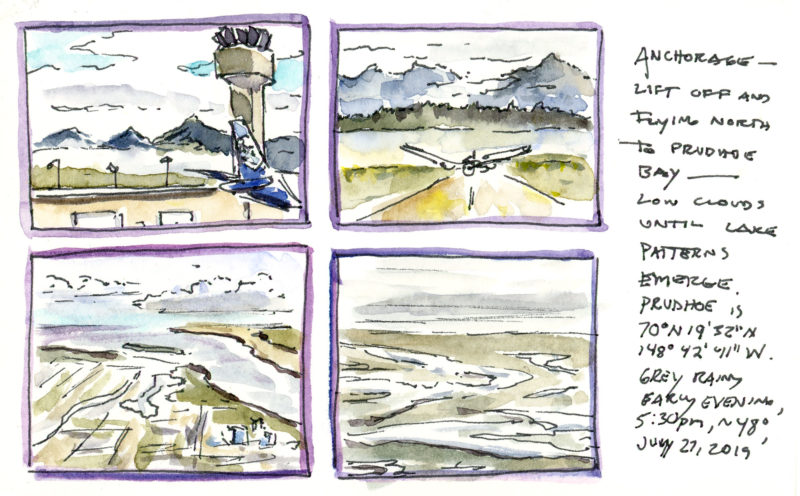
As we approached Prudhoe Bay for a brief stop before continuing on to Utqiagvik, I saw the unique patchwork landscape of “oriented thaw lakes” all aligned to the northwest. These egg-shaped lakes are some of fastest-growing lakes in the world as the permafrost melts, and their unique orientation and shape is due to the abrupt seasonal thaw of the permafrost.
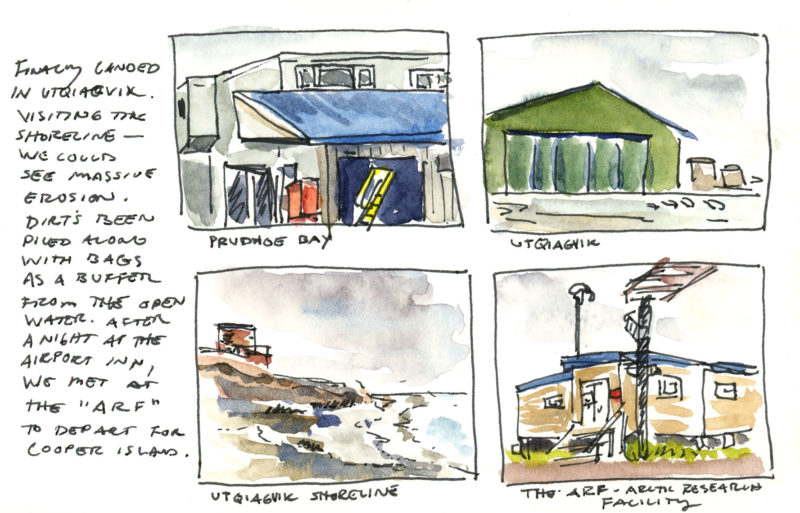
In Utqiagvik, coastal erosion is another highly visible impact from climate change. With less sea ice, the coastlines are exposed to heavier storm waves which rapidly erode the coastal bluffs, especially as the permafrost thaws.

Throughout this all is the stark beauty of the Arctic and the people whose lives are entwined with the region. Nearly 5,000 people live in Utqiagvik and roughly half are Iñupiat who maintain subsistence traditions of hunting marine mammals.
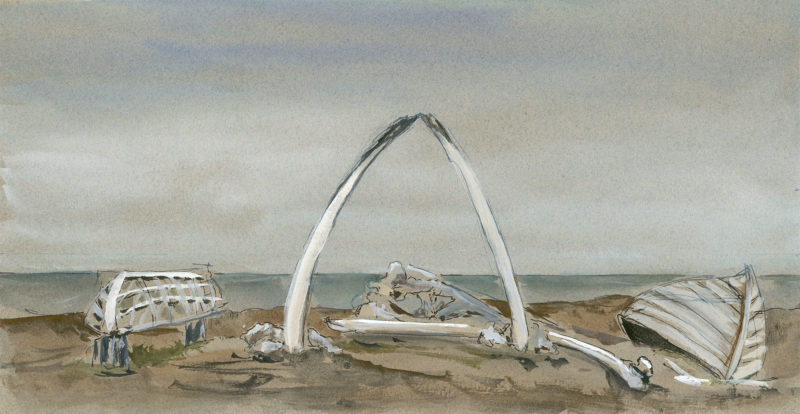
This arch made of bowhead whale jawbones represents Utqiagvik’s connection to the sea and hunting. Sketching it, I looked out over the great expanse of blue water and missed the ice.
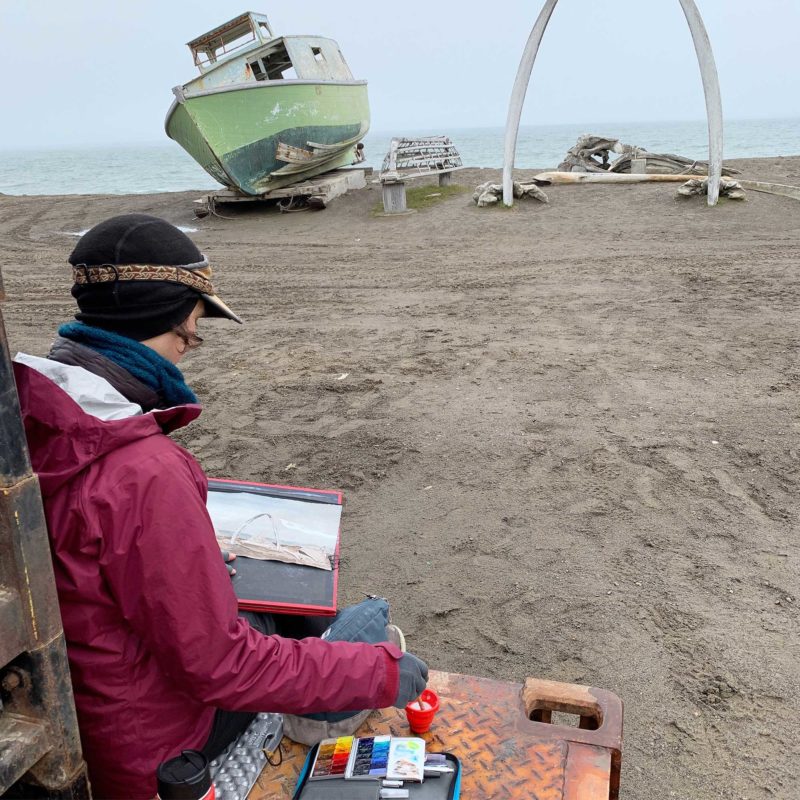
Though brief, I was thankful for our stay in Utqiagvik, and to see firsthand how the rapid recession of sea ice has a direct impact on this coastal community.
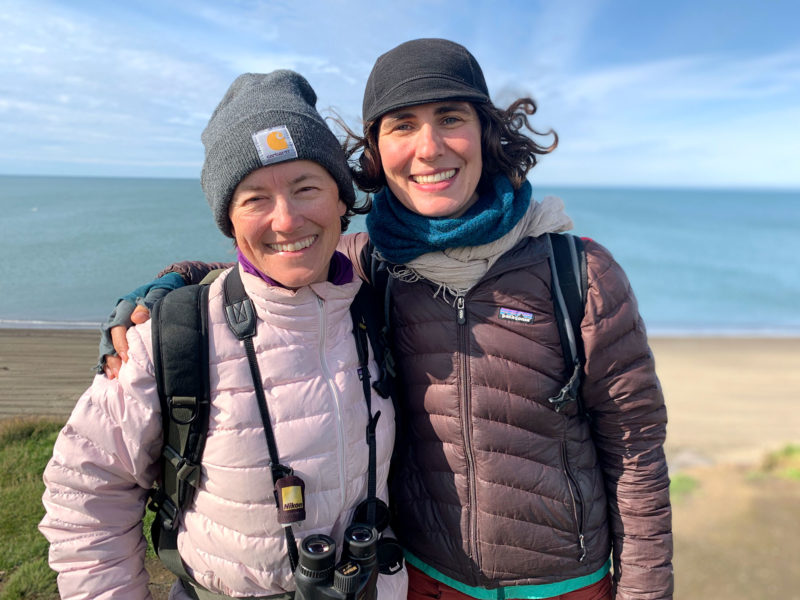
The next morning, Katie and I met at the ARF (Arctic Research Facility) to depart for Cooper Island. In my next post: First Impressions of Cooper Island.
25 Responses to “The North Slope”
Doug Elliot
Superb sketches, it’s good to record your progress.
Maria
Thank you so much!
Thomas Martin
Maria, these are simply fantastic. It is reassuring that our family has not lost its artistic talent.
Maria
Thank you, Tom! Wonderful to hear from you.
Robin
Always inspired by your works!
Maria
Thank you, Robin!
Dale Soblo
Nicely done. It’s hard not to notice climate change wherever I look. A curse of being a botanist and being told is that you see what others do not. Our art has the power to tell the stories we see. Again very nicely done. Thanks
Dale Soblo
dalesoblo.com
Maria
Thank you, Dale. Yes, artist and scientists share terrific tools for observation. There’s so much to notice in details. All my best, Maria
Rhonda Roebuck
Thank you Maria for posting about your trip. Always great to see field studies. Also, it is great to know how you travel and sketch. I know your art supplies have been tested! Look forward to more postings.
Maria
Thank you, Rhonda! I appreciate your support and encouragement, Maria
Jonathan Rutchik
Love this narrative and your lovely watercolors!!!! Such delight!
Maria
Thank you so much, Jonathan! I appreciate your support in making this project possible!
Ashley Swinton
I love everything about this! The colors, the sketches, the time spent exploring, documenting. It only adds to my own desire to go north and sketch! Southeast AK is great and FULL of inspiration, but there is an allure to the tundra, the less, the sporadic and somewhat infrequent landscape, the perfectly placed spice of color in a work, that really appeals to me. I’d love to visit Dutch Harbor personally. These artic posts just make me want to go more. :)
Maria
I hope you have the chance to visit! I’ve never been to Dutch Harbor, but it looks beautiful. Yes, I find such beautiful in the spaciousness of the tundra landscape.
Kevin M
It is great that you are using your creative skills for something so important. The impact of Climate change on so many things is very disturbing-our food supply is especially concerning.
In the past the Medieval Warm Period and the following Little Ice Age brought down considerable misery on humanity and I hope we can all see the truth and the facts of our past and not-so-distant future. Great work educating the public.
Maria
Thank you, Kevin. Yes, I hope we have political, global action and cooperation soon.
Judy Friesem
It’s a joy to travel with you. Thank you for posting; always inspiring!
Maria
Thank you for sharing my journey!
Suzy Denison
Your sketches and your commentary are fascinating, important and very
beautiful. I feel privileged to receive your information and always look
forward to hearing about your adventures, impressions and perspectives.
Suzy
Maria
I so appreciate your support and encouragement, thank you for sharing my adventures. All my best, Maria
Bonnie
Maria, your work is stunning as are the landscapes you paint. And the stories that you tell. I too am drawn to the far north, but haven’t been there in many years.
I have a practical question. How do you adhere labels to the back of your paint tins? I assume whatever you do doesn’t interfere with magnets. Thanks and I hope to take another class someday.
Maria
Thank you, Bonnie! The labels on the backs of my paint pans don’t seem to interfere with the magnets. I use my Brother P-Touch printer and the label tape is waterproof and first just right width wise. The labels are handy, especially when I’m experimenting with new colors. Cheers, Maria
Peter Becker
Having spent from 1973-1986 in and out of The Naval Arctic Research Lab there with months living on the ice, it still is well captured by your expert renderings…. and the colors are perfect….
The bluffs always were steep east of town out to the actual Point…the whale bone arch still familiar and at one time there was a New Bedford whale boat there from the age of steam whaling.. thanks for the memories rendered so well!
Maria
Thank you, Peter! It’s great to hear you memories. Best, Maria
Isabel Patchett
Hello Maria, thank you once again for sharing your travels and art with us I just love it. I will never get up to this part of our beautiful earth so to be able to share this with you through your words and art is so wonderful. Thank you also for all the information you give us about your different palettes ,colours and information about these paints is so informative . Sincerely Isabel